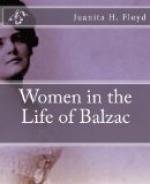“DE BALZAC.”
LA PRINCESSE BAGRATION—LA
COMTESSE BOSSI—MADAME KISSELEFF
—LA PRINCESSE DE SCHONBURG—MADAME
JAROSLAS POTOCKA
—LA BARONNE DE PFAFFINS—LA
COMTESSE DELPHINE POTOCKA
Several women whom Balzac knew, but who apparently had no special influence over his life, are mentioned here; he evidently did not care enough for them or did not know them well enough to include their names in the dedicatory register of the Comedie humaine. This, however, by no means exhausts the list of his acquaintances among women. Many of them he had met through his intimacy with his “Polar Star”; he was indeed so popular that he once exclaimed to her that he was overwhelmed with Russian princesses and took to flight to avoid them.
The noted salon of the charming Princesse Bagration, wife of the Russian field-marshal, was open to the novelist early in his career. With her aristocratic ease and the distinction of her manners, she had been one of the most brilliant stars at Vienna where her salon, as at Paris, was one of the most popular. Among her intimate friends was Madame Hamelin whom she had known during her stay in Vienna. Notwithstanding Balzac’s careless habits of dress, he was welcome in this salon, where the ladies enjoyed the stories which he told with such charm, and at which he was always the first to laugh, though told against himself.
As has been mentioned the Princess Bagration passed at Paris for the model of Foedora. If M. Gabriel Ferry is correct, Balzac met the Duchesse de Castries in the salon of the Princess Bagration before their correspondence began, but never talked to her and did not suppose that he had attracted her attention.
One of Balzac’s acquaintances whom he met during his visit to Madame Hanska at Geneva was the Countess Bossi. He met her again at Milan in 1838, on his return from his journey to Corsica, but he was not favorably impressed with her, although he once deemed it wise to explain to his Chatelaine his conduct relative to her.




